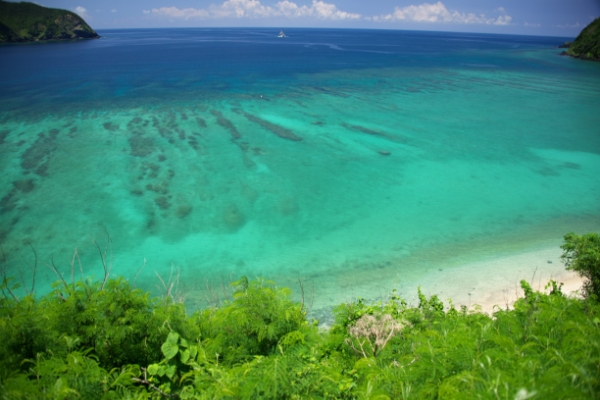

Christopher Pellegrini is the author of
THE SHOCHU HANDBOOK,
the authoritative book on Honkaku Shochu for the global audience
Christopher Pellegrini arrived in Japan in 2002 and first encountered Honkaku Shochu under the guidance of a friendly bartender. Trying the various ingredient types of Honkaku Shochu such as potato, barley, soba, and of course kokuto, he was amazed at the breadth and depth of Honkaku Shochu. Since information on Honkaku Shochu was unavailable in English, he did his own research and studies, culminating in the publication of his English language book, THE SHOCHU HANDBOOK in 2014. He continues to be involved in spreading the word on Honkaku Shochu to the rest of the world and feels Honkaku Shochu is at the cusp of international popularity, becoming a strong follow-up to the acclaim that Japanese sake has received.
Amami Kokuto Shochu’s Global Potential
The Exquisite Craftsmanship Behind Honkaku Shochu
“Amami Kokuto Shochu is classified as a Honkaku Shochu and is made by pot distillation. Pot distillation is a straightforward method of distillation and has been around for ages. While the method is simple, however, making good Honkaku Shochu is complicated because flavor agents such as ingredients and moromi, (fermented mash) that arise from fermentation tend to remain and these need to be managed. Further, unlike other fermented drinks such as beer and wine, both Honkaku Shochu and sake go through a highly complex technique called multiple parallel fermentation that involves both saccharification and ethanol fermentation at the same time. I would say pot distillation and parallel fermentation make Honkaku Shochu a product of a much more difficult process than the king of distilled drinks, whiskey. Speaking of whiskey, while the aroma of whiskey is essential, it originates from the characteristics of the barrel that transfers at later phases of production. The key scent of Honkaku Shochu* is from moromi, however, and the quality of moromi directly affects the aroma of the finished product – again, requiring top-level techniques.”
*the scent of Honkaku Shochu: some Honkaku Shochu brands are also barrel-aged which can impart whiskey-like aromas
Honkaku Shochu goes beyond the “Distilled Drink” categorization
“When we talk moromi or fermentation culture in shochu, it’s more akin to craft beer than to whiskey. Said another way, Honkaku Shochu is like the craft beer of distilled liquor. What I mean is, Honkaku Shochu is a superb drink for during meals, just like craft beer, and goes well with a variety of dishes, again like craft beer. No other distilled drinks can deliver like this, except for Honkaku Shochu.”
“The other appeal of Honkaku Shochu is how you can not only taste the wide variety of ingredients, you can also taste the difference based on where it’s made, similar to the terroir in wine.”

The Joy of Amami Kokuto Shochu
“In Amami Kokuto Shochu, you can enjoy a diverse array of flavors such as light palate, deep flavor, fruity taste, and so on, but when you know these kokuto shochu are made only in the Amami Islands, and moreover from only 26 distilleries, the diversity and variation are truly incredible. Every island in the Amami archipelago is distinct and has a truly unique terroir based on its history and natural environment. You can structure your exploration according to the soil, water, distiller, or farmer, and the fascination never ends.”
How I Like to Enjoy Amami Kokuto Shochu
“Once you become familiar with Amami Kokuto Shochu, the potential of mixing it oyuwari (with hot water) becomes evident. The hot water makes the sweetness, umami, and aroma more prominent, helping drinkers to discover a new side to the brand. If it is a 25% shochu, I would try a 60-to-40 shochu-to-hot water combo. If it’s a 30% to 35% shochu, a 40-to-60 mix with shochu being the 40.”
“Outside of Japan, not many cultures drink alcoholic beverages mixed with hot water, so it may not take off very quickly. But if there is a continual message of how this is a standard way of enjoying Honkaku Shochu in Japan, people will begin to see the light and it will become an acquired taste.”
“Another interesting way of drinking Amami Kokuto Shochu on the rocks is to add a dash of water (choimizu) if it is stronger than 40%. Heating a 25% shochu to about 45℃, as you would sake, also works. Better yet, splash the warmed shochu onto a ball of ice and drink it on the rocks, and feel the change in taste. My latest passion is experimenting with different sodas to mix with shochu – I have a soda-making appliance that can make seltzer with varying levels of carbonation. The flavor of the drink changes with the fineness of the carbonated bubbles, surprising me every time. Honkaku Shochu and Amami Kokuto Shochu have so much more to offer, and I’m looking forward to what’s ahead.”

